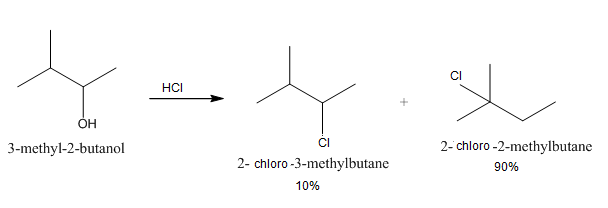
For $3 - {{methyl}} - 2 - {{butanol}} $ on treatment with $\xrightarrow {{dryHCl}} $gives predominantly:
A.$2 - $chloro$2 - $methylbutane
B.$2 - $chloro$2 - $methylbutane
C.$2 - $$2 - $dimethylbutane
D.None of the above.
Answer
448.2k+ views
Hint: To attempt this question first draw the structure of \[3 - \]methyl\ [- 2 - \]butanol and treat it with hydrochloric acid or$HCl$. The product will be a carbocation, after getting the product we have to look for the stability of carbocation and rearrange it accordingly.
Complete step by step answer:

The mechanism of this reaction involves $4$ steps
Step: 1
Protonation: is also known as hydro nation is addition of proton or a hydrogen cation to an atom, molecule. This forms a conjugate acid of that particular compound. In this question the \[3 - \]Methyl\ [- 2 - \]butanol accepts a pair of protons which gets attached to the $'OH'$ ion.
Step: 2
Now the formation of carbocation takes place. Carbocation is a molecule in which a carbon atom has $3$ positive charges. This is also known as carbonium ion. It is divided into $3$ groups, primary, secondary and tertiary. After the attachment of the proton to the $'OH'$ ion a secondary carbocation is formed by the elimination of water ${H_2} O$.
Step: 4
After the elimination of water, a hydride shift takes place. Hydride shift is a type of rearrangement in a carbocation. In this type of shift the hydrogen atom in a carbocation migrates to the carbon atom which has the formal charge of $ + 1$(carbon$2$) from an adjacent carbon (carbon$1$).
Step: 5
After the hydride shift the tertiary carbocation is formed which is more stable. Now the \['Cl'\] molecule attacks on the tertiary carbocation which is also known as the nucleophilic attack.
The answer is A. $2 - $$2 - $chloro$2 - $methylbutane
Note:
Unimolecular substitution reactions are favoured when tertiary substrates such as 3-methyl2-butanol are reacted with a good nucleophile such as chlorine ion under protic aprotic conditions that is in acidic medium.
Complete step by step answer:

The mechanism of this reaction involves $4$ steps
Step: 1
Protonation: is also known as hydro nation is addition of proton or a hydrogen cation to an atom, molecule. This forms a conjugate acid of that particular compound. In this question the \[3 - \]Methyl\ [- 2 - \]butanol accepts a pair of protons which gets attached to the $'OH'$ ion.
Step: 2
Now the formation of carbocation takes place. Carbocation is a molecule in which a carbon atom has $3$ positive charges. This is also known as carbonium ion. It is divided into $3$ groups, primary, secondary and tertiary. After the attachment of the proton to the $'OH'$ ion a secondary carbocation is formed by the elimination of water ${H_2} O$.
Step: 4
After the elimination of water, a hydride shift takes place. Hydride shift is a type of rearrangement in a carbocation. In this type of shift the hydrogen atom in a carbocation migrates to the carbon atom which has the formal charge of $ + 1$(carbon$2$) from an adjacent carbon (carbon$1$).
Step: 5
After the hydride shift the tertiary carbocation is formed which is more stable. Now the \['Cl'\] molecule attacks on the tertiary carbocation which is also known as the nucleophilic attack.
The answer is A. $2 - $$2 - $chloro$2 - $methylbutane
Note:
Unimolecular substitution reactions are favoured when tertiary substrates such as 3-methyl2-butanol are reacted with a good nucleophile such as chlorine ion under protic aprotic conditions that is in acidic medium.
Recently Updated Pages
Master Class 12 Economics: Engaging Questions & Answers for Success

Master Class 12 Maths: Engaging Questions & Answers for Success

Master Class 12 Biology: Engaging Questions & Answers for Success

Master Class 12 Physics: Engaging Questions & Answers for Success

Master Class 12 Business Studies: Engaging Questions & Answers for Success

Master Class 12 English: Engaging Questions & Answers for Success

Trending doubts
Which are the Top 10 Largest Countries of the World?

Differentiate between homogeneous and heterogeneous class 12 chemistry CBSE

What is a transformer Explain the principle construction class 12 physics CBSE

Who is Mukesh What is his dream Why does it look like class 12 english CBSE

Draw a labelled sketch of the human eye class 12 physics CBSE

What are the major means of transport Explain each class 12 social science CBSE




